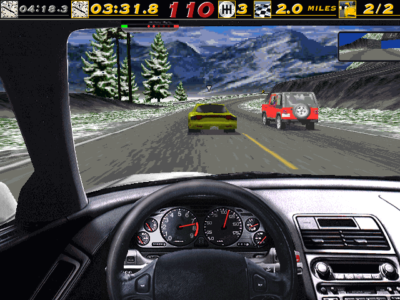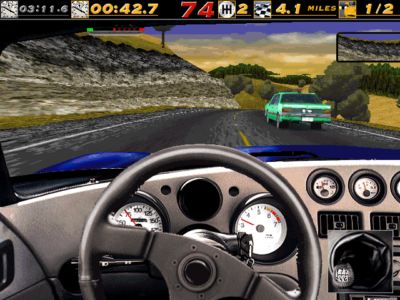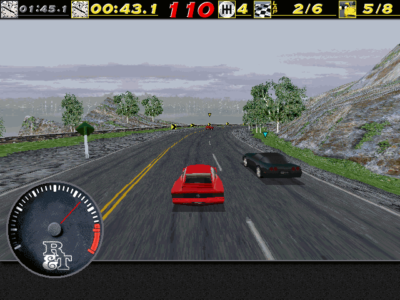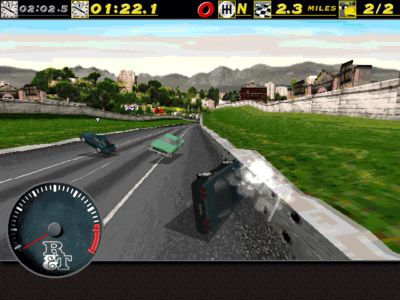Written by: Rik
Date posted: September 2, 2021
In recognition of the unlikely-sounding milestone that is this site’s 20th birthday, we’re going back to a few of our old reviews. But, as part of our ongoing commitment to you, the reader, to produce around 15 or so new reviews per year (no, I don’t know how we do it, either), we’re tying in such frippery with a companion review of a related title.
And so, in recognition of finally taking a look at the second game in the Need for Speed series, we’re going back to the first one too.
Your correspondent’s recollection is that the third Need for Speed game, Need for Speed III: Hot Pursuit, was the first to be covered on FFG, swiftly followed by a review of the original, a fact borne out by the review dates currently given (mid-2004), but not by a recent archaeological dig to unearth evidence of the site’s earliest days, which revealed that both reviews were present and correct prior to that, in 2003.
(Said dig also confirmed that there was no discrete racing section back then, with NFS games being bundled in the Simulation section, which was itself kept separate from one for Spaceflight games. And, going back even further, it seems that the RPG reviews were once filed under ‘Beards’, action games under ‘Carnage’ and strategy titles under ‘Megalomania’).
Given our predilection for tinkering with old content in those days (which evidently has never abated), it seems likely that one or both reviews were re-written at some point and linked to each other, with an apparent element of crossover between the two. The general thrust of that ancient and dusty prose seems to have been to generally espouse the qualities of the third game, while also lamenting the fact that it still sort of abandoned something special about the first.
To involve Need for Speed III in this piece would involve rather too much unpicking of the past for even such a self-indulgent exercise as this, and given the amount of coverage the NFS series has had here over the years, and (especially) the number of times I seem to have repeated the same points about roads vs tracks while briefly recapping elements of the series history, we’ll leave that one alone for now. (I can, however, confirm that it’s something that I revisit periodically and, with the benefit of modern patches to get it running, it still seems to hold up, even if some of the good feeling it generates may well be nostalgia-assisted).
So, let’s talk about The Need for Speed, then, a game that also holds a special place in my heart as one of the first full-price CD-ROM titles that I ever owned, a fact possibly related to the retention of that copy through to the present day. As noted elsewhere, a childhood obsession with cars led to a similar one with racing games that let you drive expensive ones on the open road. Where Test Drive had once been, The Need for Speed would follow. It was a prestige title with gorgeous graphics, and a significant carrot for potential 3DO owners until that system’s commercial failure, before it was beefed up a little for a PC release.
With the previous write-up shamefully light on even such basic details, it’s worth belatedly recording here that the 3DO version featured only the three ‘Road’ courses, upon which you had to negotiate civilian traffic as well as the attentions of the police, with the other three ‘Track’ circuits, which involved driving round and around in circles, being added for the PC release. (3DO gamers also had the dubious pleasure of being smack-talked in video clips by an opposing racer known variously as ‘X-Man’ or ‘Mister X’, thankfully removed from later editions).
Looking back, the distinction between the road and track sections was probably not elaborated upon fully because the latter were of absolutely no interest to me whatsoever, and certainly not part of why the game was noteworthy or deserving of the attention of gamers who missed it first time around. In hindsight, though, their addition, along with two further circuit courses in the subsequent Special Edition of The Need for Speed in 1996 should have provided some hints as to the general direction of travel for the series and prevented me from being quite so shocked and appalled at the focus of the sequel proper.
Having taken some time to go back to the game and spend some time on these tracks, it’s worth saying that The Need for Speed is pretty unsatisfying as a lap-based racer. Judged on these three courses alone, the second game does a much better job of providing light auto-based japes in which you race a handful of other fast cars around a circuit. Despite some issues with the handling in NFS II, it still beats wrestling with your car here upon encountering a sharp corner: having rarely exceeded the national speed limit in real life, I have no idea whether getting a Ferrari around a bend at 120mph is really like pushing an over-laden shopping cart through the exit doors at Tesco, but it certainly doesn’t make for an enjoyable racing experience in game-land.
That said, switching back to the ‘Road’ sections shows the game in a better light. It really is like an upgraded version of Test Drive II: The Duel: a race through various environments against a single opponent, with each of you driving the car of your choice. This was the version I played endlessly in the past, with each course offering its own memorable moments: the long straights and one-way traffic of the City highways that allowed you to get a Diablo up to the seemingly mythical 200mph mark; the sight of hot-air balloons rising over a hill during the Coastal section; and the fiendishly difficult snowy curves of the final stretch of Alpine road, upon which I once managed to defeat the mighty Diablo with the humble Mazda RX-7 (yes, my opponent crashed).
In truth, I actually cared little whether I won or lost, only that I never got arrested by the police (the prospect of which seemed extremely distant this time around, reinforcing my existing notions that my past self was some kind of gaming doofus). The fun was in feeling as if each particular head-to-head race would be different, and you could make it so, to a certain extent, by changing up the two vehicles according to your preferences.
Despite fears that I might have been a little creative about the supposedly endless possibilities that these sections seemed to present to my teenage mind, revisiting them again showed them to have aged rather well. Each provides around 10-15 minutes of road racing in total, and they remain rather suited to brief, one-off challenges, at the end of which, the importance of victory or defeat does indeed seem rather incidental to your enjoyment.
On that note, I was reminded that it can be a rather tough beast to conquer at times, especially as it retains the feature from the Test Drive games that the two vehicles’ cumulative time over the three stages of each course is what counts, rather than whether one finishes ahead of the other ‘on the road’ in each one. Your opponents, and chasing police cars, are both upon you in an instant if you dawdle, with your rear view mirror, as in Test Drive, being invaluable when blocking. Serious prangs, meanwhile, usually have dire consequences for your chances of winning, or avoiding a speeding ticket (or arrest, if things have got to that stage).
Clearly, The Need for Speed is no simulation, but it does have that feeling of driving those expensive cars for real, particularly using the in-car view, that your standard arcade caper doesn’t. It’s also one of the few games to persuade me to switch to manual transmission, in an effort to feel slightly more in control, under the (possibly misguided) apprehension that doing so would allow me to squeeze a bit more power out of my chosen 90s supercar.
And so, the driving is fun, even in some of the slower cars, which is one of those rare and often unheralded pleasures in a racer. This despite the fact that the handling does remain problematically ungraceful at times, and although its shortcomings are less often highlighted on the road than on the aforementioned circuits, there remains plenty of undignified – and unsuccessful – straining during any particularly twisty sections.
Looking back at the original review, the summary of ‘great concept, why hasn’t it been updated?’ probably needs to be considered in the context of a world that had not yet seen 2005’s Need for Speed: Most Wanted, which included plenty of open road driving but rather dialled-up the police tension, or 2007’s Test Drive Unlimited, which was perhaps more of a spiritual successor to this first Need for Speed title than any of its actual sequels. In my mind, it took far too long to get from this game to those, which probably coloured my occasionally hysterical ramblings about NFS in the intervening period.
As for my evaluation of this one… well, to the existing review, I’d probably also add: ‘well, of course the graphics have dated, you dummy’ but, that said, aside from some cars, particularly the generic civilian ones, having a certain box-like quality, the visuals have held up rather well. I always liked that it was striving for photorealism, as far as technology allowed, which the immediate sequels never quite seemed able to build on.

Chasing the RX-7. You do genuinely feel as if you’re racing your opponent, rather than them just being a drone floating along ahead of you.
The ‘invisible wall’ that I mentioned getting in the way is definitely there, although it’s slightly wider than I perhaps remembered, or suggested back then, and there are opportunities to sneak around traffic on the outside rather than just coming to an immediate halt the moment you leave the track. Also, I think I slightly over-egged the extent to which you could dodge the attentions of the police by slowing down to the posted limit – it’s fairly easy if they’re sat waiting at the side of the road, less so if you need to overtake them on the highway.
There is a tournament mode, but it removes traffic and just has you racing on empty roads, as well as the circuit tracks, against a pack of opponents, and so is rather dull. There’s no structured alternative based on beating opponents in head-to-head mode, although individual victories here do earn you the reward of a video clip, complete with 90s power-guitar backing. (Speaking of which, a hat tip to the menu music, which I never really appreciated before, but made me want to rock out this time around, for some reason).
Looking back, I could perhaps have been slightly more generous with my final score for this one (I have the recurring thought that maybe some of my 5s should be 6s, and some of my 6s should be 7s, but that way madness lies…) but the general picture of a once good-looking game with a great idea at its heart let down slightly by ropey handling remains one that I recognise. I certainly prefer it to the sequel, which still represents somewhat of a betrayal of the concept, a betrayal which sort of extends to the third one as well, even though it remains a superior game.
All of which I’ve mentioned already, of course… what was I saying about repeating myself?
—
The Need for Speed is available on abandonware sites and will be much easier to get running, and grab screenshots from, than it was in 2004.





 Posts
Posts
I petition to bring back Beards, Carnage and Megalomania categories.
September 6, 2021 @ 10:56 pm
Heh heh… We’re talking 2001-2002 era there. The kind of stuff I’d definitely forgotten about altogether!
September 8, 2021 @ 10:21 am